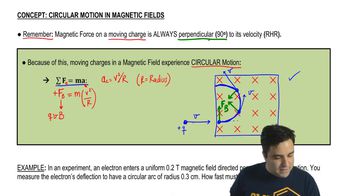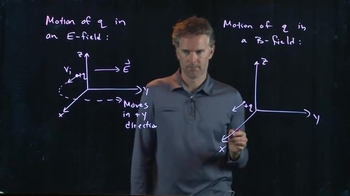Okay, so let's say we have a region of space here, and in this region of space we have a B field that is everywhere going into the screen. And B field is everywhere pointing into the screen. And now you want to put a charge in this thing and send it flying through. So I'm going to take a q and let's see, which way do I want to send it? I want to start right here, we'll make it a positive q, and let's send it this way. Alright, this thing is gonna feel a force, and it certainly has to feel a force either up or down. Okay, remember B is going into the screen. So, which way is that force going to be? Is it up or is it down? Look at the computer monitor over there, pick up your right hand, put your finger straight in the direction of V, curl them into the screen for the direction of B. Which way is the force? It's got to be up or down. What do you guys think? Anybody get an answer on that one? Let's try it. V is going to the right. B is into the screen so I'm going to curl my fingers into the screen right? That's to you what looks like into the screen? Okay, and so I'm going to end up with a force that is up and that means that this thing is going to move in a circle. That particle that came flying in is, in fact, going to move around in a circle Is that right? Did everybody see that? Okay? V is to the right, B is in to the screen, thumb as the direction of force, so it's towards the center of a circle at this point. Later on, V is going up, B is into the screen, and so I again get a force towards the center of the circle. And everywhere around it's always a force towards the center of the circle. Okay, but we know what that force is, it's qVB sine of theta. let's just worry about the magnitude of it, we already figured out the direction qVB, what's the angle between those two? Well V was to the right, B was into the screen, and so we get 90 degrees, but 90 degrees is just one. So what's the force? qVB. Alright. But this thing is moving in a circle now, of radius r. And what we know from last semester is if things are moving in a circle, we can consider the forces adding up to something very specific, namely mv squared over r. Right, this is uniform circular motion, the centripetal force is mv squared over r. But the only force is this magnetic force. Okay, and so that becomes the left side of this equation. So we get qVB equals mv squared over R. And now we can quickly solve this thing for the radius. Alright, I multiply by R I'm gonna divide by qVB, one of the V's is going to cancel out and I get mV over qB. What's the radius of that circle? It's that. It's the momentum of the particle divided by the charge times the magnetic field. So when you are doing a high energy physics experiment and you create all these charged particles that are moving very quickly, how can you determine something about them? W ell you put them in a big magnetic field and you watch them spin around in a circle and when you do that you can determine this quantity right here. All you have to do is determine the radius of the circle. And so when you see those pictures from CERN and places like that where they have particles coming in and then doing this sort of stuff and this sort of stuff and all these circles and beautiful pictures like that, what those are are charged particles moving through magnetic fields. And from those pictures, all they have to do is measure the radius and if they know the magnetic field that was in there they can figure out something about how fast it's moving. What's the mass? What's the charge on it? Positives are gonna go this way. Negatives are gonna go the other way Ones that are very lightly charged, have a small q, have a bigger radius. If they have a bigger mass they have a bigger radius And so you can determine a lot just from taking these sorts of pictures. And it's really not that complicated, right? We just did it with the force law, magnetic force law, and the centripetal force law
Table of contents
- 0. Math Review Coming soon
- 1. Intro to Physics Units1h 24m
- 2. 1D Motion / Kinematics3h 56m
- Vectors, Scalars, & Displacement13m
- Average Velocity32m
- Intro to Acceleration7m
- Position-Time Graphs & Velocity26m
- Conceptual Problems with Position-Time Graphs22m
- Velocity-Time Graphs & Acceleration5m
- Calculating Displacement from Velocity-Time Graphs15m
- Conceptual Problems with Velocity-Time Graphs10m
- Calculating Change in Velocity from Acceleration-Time Graphs10m
- Graphing Position, Velocity, and Acceleration Graphs11m
- Kinematics Equations37m
- Vertical Motion and Free Fall19m
- Catch/Overtake Problems23m
- 3. Vectors2h 43m
- Review of Vectors vs. Scalars1m
- Introduction to Vectors7m
- Adding Vectors Graphically22m
- Vector Composition & Decomposition11m
- Adding Vectors by Components13m
- Trig Review24m
- Unit Vectors15m
- Introduction to Dot Product (Scalar Product)12m
- Calculating Dot Product Using Components12m
- Intro to Cross Product (Vector Product)23m
- Calculating Cross Product Using Components17m
- 4. 2D Kinematics1h 42m
- 5. Projectile Motion3h 6m
- 6. Intro to Forces (Dynamics)3h 22m
- 7. Friction, Inclines, Systems2h 44m
- 8. Centripetal Forces & Gravitation7h 26m
- Uniform Circular Motion7m
- Period and Frequency in Uniform Circular Motion20m
- Centripetal Forces15m
- Vertical Centripetal Forces10m
- Flat Curves9m
- Banked Curves10m
- Newton's Law of Gravity30m
- Gravitational Forces in 2D25m
- Acceleration Due to Gravity13m
- Satellite Motion: Intro5m
- Satellite Motion: Speed & Period35m
- Geosynchronous Orbits15m
- Overview of Kepler's Laws5m
- Kepler's First Law11m
- Kepler's Third Law16m
- Kepler's Third Law for Elliptical Orbits15m
- Gravitational Potential Energy21m
- Gravitational Potential Energy for Systems of Masses17m
- Escape Velocity21m
- Energy of Circular Orbits23m
- Energy of Elliptical Orbits36m
- Black Holes16m
- Gravitational Force Inside the Earth13m
- Mass Distribution with Calculus45m
- 9. Work & Energy1h 59m
- 10. Conservation of Energy2h 54m
- Intro to Energy Types3m
- Gravitational Potential Energy10m
- Intro to Conservation of Energy32m
- Energy with Non-Conservative Forces20m
- Springs & Elastic Potential Energy19m
- Solving Projectile Motion Using Energy13m
- Motion Along Curved Paths4m
- Rollercoaster Problems13m
- Pendulum Problems13m
- Energy in Connected Objects (Systems)24m
- Force & Potential Energy18m
- 11. Momentum & Impulse3h 40m
- Intro to Momentum11m
- Intro to Impulse14m
- Impulse with Variable Forces12m
- Intro to Conservation of Momentum17m
- Push-Away Problems19m
- Types of Collisions4m
- Completely Inelastic Collisions28m
- Adding Mass to a Moving System8m
- Collisions & Motion (Momentum & Energy)26m
- Ballistic Pendulum14m
- Collisions with Springs13m
- Elastic Collisions24m
- How to Identify the Type of Collision9m
- Intro to Center of Mass15m
- 12. Rotational Kinematics2h 59m
- 13. Rotational Inertia & Energy7h 4m
- More Conservation of Energy Problems54m
- Conservation of Energy in Rolling Motion45m
- Parallel Axis Theorem13m
- Intro to Moment of Inertia28m
- Moment of Inertia via Integration18m
- Moment of Inertia of Systems23m
- Moment of Inertia & Mass Distribution10m
- Intro to Rotational Kinetic Energy16m
- Energy of Rolling Motion18m
- Types of Motion & Energy24m
- Conservation of Energy with Rotation35m
- Torque with Kinematic Equations56m
- Rotational Dynamics with Two Motions50m
- Rotational Dynamics of Rolling Motion27m
- 14. Torque & Rotational Dynamics2h 5m
- 15. Rotational Equilibrium3h 39m
- 16. Angular Momentum3h 6m
- Opening/Closing Arms on Rotating Stool18m
- Conservation of Angular Momentum46m
- Angular Momentum & Newton's Second Law10m
- Intro to Angular Collisions15m
- Jumping Into/Out of Moving Disc23m
- Spinning on String of Variable Length20m
- Angular Collisions with Linear Motion8m
- Intro to Angular Momentum15m
- Angular Momentum of a Point Mass21m
- Angular Momentum of Objects in Linear Motion7m
- 17. Periodic Motion2h 9m
- 18. Waves & Sound3h 40m
- Intro to Waves11m
- Velocity of Transverse Waves21m
- Velocity of Longitudinal Waves11m
- Wave Functions31m
- Phase Constant14m
- Average Power of Waves on Strings10m
- Wave Intensity19m
- Sound Intensity13m
- Wave Interference8m
- Superposition of Wave Functions3m
- Standing Waves30m
- Standing Wave Functions14m
- Standing Sound Waves12m
- Beats8m
- The Doppler Effect7m
- 19. Fluid Mechanics2h 27m
- 20. Heat and Temperature3h 7m
- Temperature16m
- Linear Thermal Expansion14m
- Volume Thermal Expansion14m
- Moles and Avogadro's Number14m
- Specific Heat & Temperature Changes12m
- Latent Heat & Phase Changes16m
- Intro to Calorimetry21m
- Calorimetry with Temperature and Phase Changes15m
- Advanced Calorimetry: Equilibrium Temperature with Phase Changes9m
- Phase Diagrams, Triple Points and Critical Points6m
- Heat Transfer44m
- 21. Kinetic Theory of Ideal Gases1h 50m
- 22. The First Law of Thermodynamics1h 26m
- 23. The Second Law of Thermodynamics3h 11m
- 24. Electric Force & Field; Gauss' Law3h 42m
- 25. Electric Potential1h 51m
- 26. Capacitors & Dielectrics2h 2m
- 27. Resistors & DC Circuits3h 8m
- 28. Magnetic Fields and Forces2h 23m
- 29. Sources of Magnetic Field2h 30m
- Magnetic Field Produced by Moving Charges10m
- Magnetic Field Produced by Straight Currents27m
- Magnetic Force Between Parallel Currents12m
- Magnetic Force Between Two Moving Charges9m
- Magnetic Field Produced by Loops andSolenoids42m
- Toroidal Solenoids aka Toroids12m
- Biot-Savart Law (Calculus)18m
- Ampere's Law (Calculus)17m
- 30. Induction and Inductance3h 37m
- 31. Alternating Current2h 37m
- Alternating Voltages and Currents18m
- RMS Current and Voltage9m
- Phasors20m
- Resistors in AC Circuits9m
- Phasors for Resistors7m
- Capacitors in AC Circuits16m
- Phasors for Capacitors8m
- Inductors in AC Circuits13m
- Phasors for Inductors7m
- Impedance in AC Circuits18m
- Series LRC Circuits11m
- Resonance in Series LRC Circuits10m
- Power in AC Circuits5m
- 32. Electromagnetic Waves2h 14m
- 33. Geometric Optics2h 57m
- 34. Wave Optics1h 15m
- 35. Special Relativity2h 10m
28. Magnetic Fields and Forces
Circular Motion of Charges in Magnetic Fields
Struggling with Physics?
Join thousands of students who trust us to help them ace their exams!Watch the first videoVideo duration:
6mPlay a video:
Related Videos
Related Practice





